 | « Back to article | Print this article |
His cricketing brain, always sharp, was blessed with exceptional speed of information absorption and processing.
He could quickly zero in on what needed to be done and use the element of surprise to overpower the opposition, observes Shreekant Sambrani.
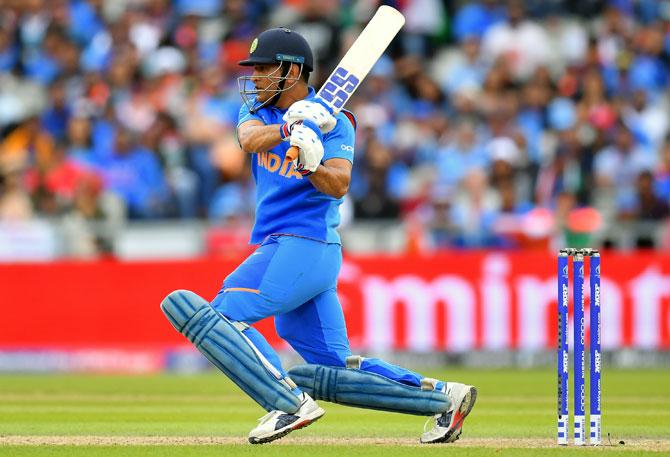
Mahendra Singh Dhoni's greatest achievement was not in any cricket match or on any cricket field.
15 August 2020 is more likely to be remembered not just as the 74th Independence Day of India when the prime minister articulated his vision of 'Atmanirbhar Bharat' from the ramparts of the Red Fort in Delhi, but also as the day when the greatest and best captain of the Indian cricket team in all formats of the game announced his retirement from international cricket on social media with the flourish and panache we have come to associate with him.
Surely, upstaging Narendra Modi, the orator par excellence, on a day that ought to have been entirely his, is a feat unequalled by anything Dhoni did as captain, wicketkeeper, batsman and bowler (on a few memorable occasions) in any cricket match anywhere!
In 2004, I was tracking the progress of the India A team on a tour of Zimbabwe and Kenya.
I saw that one M S Dhoni figured consistently in the summary scores posted on ESPN Cricinfo.
I told my wife, an even more ardent cricket buff, that there was this young player I didn't know from where who was raking up big scores in match after match.
Apparently I wasn't the only one who noticed Dhoni's exploits.
He was immediately pressed into the India squad for ODIs against Bangladesh that year.
But Dhoni had the ignominy of being run out for a duck in his very first ODI (he was run out in his last ODI as well, but not for a duck, perhaps the only player to sport this record, but more about that later).
Neither his batting nor his wicket-keeping was worthy of mention in the rest of that series.
But luckily for Indian cricket, Captain Saurav Ganguly persisted with him in the next home series against Pakistan.
In the second match, Dhoni scored a match-winning century.
He then became a permanent fixture of Indian teams in all formats, also its captain, with an unmatched record of longevity and more importantly, winning.
The list of records he holds is as long as an arm - the number of matches captained, number of wins, number of dismissals behind the wicket, number of runs at various positions, averages and so on.
But this column is not about records and statistics.
They can be found on the Internet with just a few keystrokes.
What is more important to me is the lasting contribution Dhoni made as a captain, wicket-keeper and batsman to Indian cricket.
***
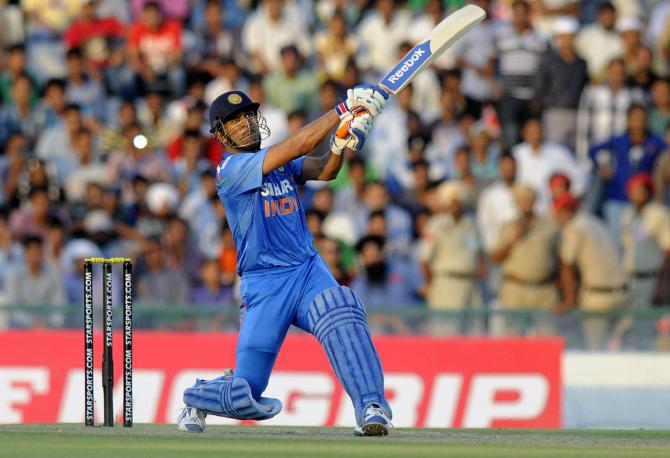
That Dhoni was unlike any other Indian captain became evident from his first major outing in that capacity, the inaugural ICC T20 World Cup of 2007.
Individual feats such as Yuvraj Singh's six sixes in a Stuart Broad over or Irfan Pathan's inspired bowling, may have won specific games, but the overall cup victory was almost entirely due to Dhoni's inspired captaincy.
At the cost repeating for the nth time, Dhoni's tossing the ball to the hitherto (and thereafter as well) unknown Joginder Sharma for the last over of the final against Pakistan, when an in-form Misbah-ul-Haque threatened to take his team home, was an act of sheer genius, who knew exactly how to keep cool under immense pressure and surprise the opponent with an unexpected and untried weapon from his armoury.
Until the Dhoni captaincy, Indian batting was formidable, but its bowling could not be depended upon to deliver.
In test matches, it could seldom take 20 wickets and in limited overs games, it often could not defend respectable scores put up by the batting side.
Brilliant performances by the likes of Anil Kumble, Zaheer Khan and Harbhajan Singh did not always result in dismissing the other side with a moderate score, because they ploughed mostly a lonely furrow.
Dhoni started to mould together a bowling ensemble.
He used the available resources -- R P Singh, Irfan Pathan, Munaf Patel, Pravin Kumar, Ishant Sharma, none of them fearsome speed merchants -- effectively, making them bowl in shorter spells, within their limits and to a set field.
This discipline lent an edge to the attack that was not seen earlier.
In Ravichandran Ashwin, Dhoni had not only a world-class spinner but also a fierce competitor.
The attack started to gel nicely and it delivered first in the ICC ODI World Cup of 2011 and then the Champion's Trophy in 2013.
Getting the rather wayward Ishant to bowl the crunch over in the truncated final in 2013, when he got two set batsmen out, who would have otherwise won the match for England, was again an inspired act of captaincy.
The arrival of Mohammed Shami and Bhuvaneshwar Kumar and a little later, Jaspreet Bumrah, made the Indian pace attack a lethal weapon.
The finger spin twins Yuzuvendra Chahal and Kuldeep Yadav made it a world-beating outfit, which Dhoni could pass on to Virat Kohli as his legacy.
But that was not all.
Dhoni sharpened the fielding.
He was ruthless early on in his career in insisting that the seniors, stars though they may have been, could not be hidden in the field and thus did not belong any longer in the team.
That bitter pill administered, Dhoni changed the playbook so that the younger, fitter side not only held catches, but also saved runs by diving and intelligent throwing.
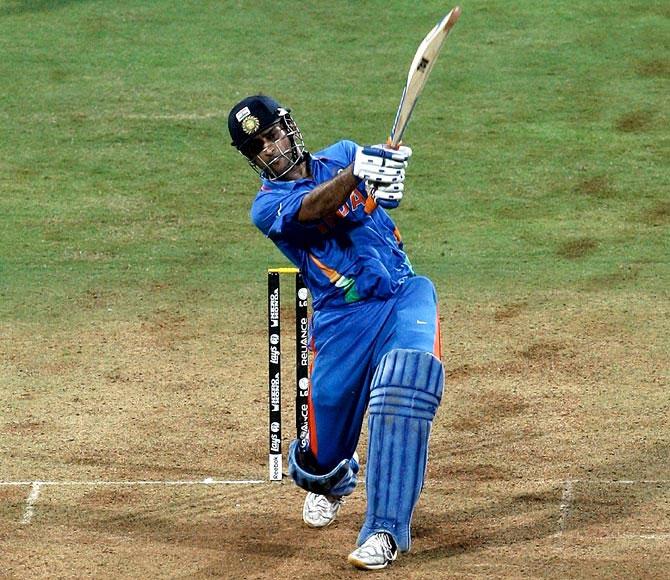
All this changed the team's mindset.
Ganguly had brought aggression into the team through personal example.
Dhoni knew that that alone was not sufficient.
With his tactics, he built up the team confidence and belief in itself.
The team played to win, not avoid being beaten.
Dhoni's biggest contribution was thus the removal of the fear of losing.
Because Dhoni's decisions were often split-second ones, many call his captaincy instinctive.
That is doing his intellect and analytical abilities a grave injustice.
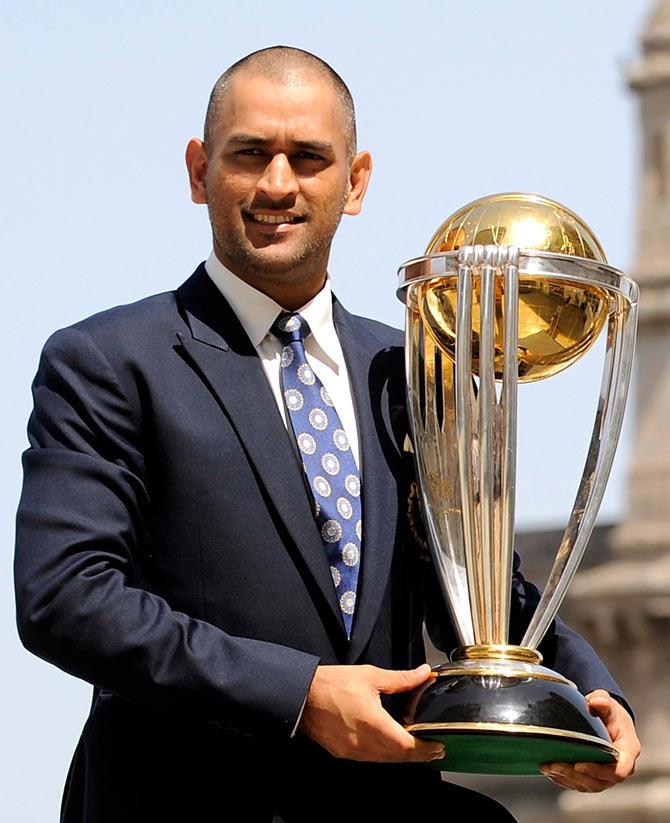
His cricketing brain, always sharp, was blessed with exceptional speed of information absorption and processing.
He could thus quickly zero in on what needed to be done and use the element of surprise to overpower the opposition.
In 2018, Sandeep Dwivedi, the sports editor of The Indian Express, asked S S Rajmouli, the creator of the epic Baahubali films and a huge fan of Dhoni, which of the two Baahubalis did Dhoni resemble, Amrendra the father or Mahendra the son.
Rajmouli immediately said Amarendra, because he was deliberative, while Mahendra was more a creature of impulses.
Rajmouli was spot on.
***
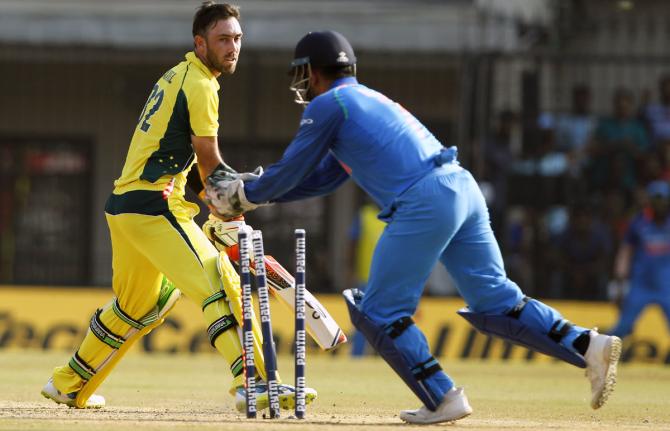
Dhoni the wicket-keeper owns all the Indian wicket-keeping records and most of the limited overs records world-wide.
He was in eight of the annual ICC ODI teams (half of them as captain as well).
And he was playing in the times of such champion 'keepers as Adam Gilchrist of Australia and Kumar Sangakkara of Sri Lanka.
But that was not always so.
In his early years, Dhoni was quite erratic, provoking a sharp rebuke from the veteran Syed Kirmani.
Dhoni set about to change all this with his characteristic determination and energy.
Change he did and how! He was lightening quick to remove the bails if the batsmen stepped even a centimetre out of the crease for what seemed to be only a flick of an eyelid.
The slo-mo replays caught this act of wizardry and won Dhoni many a wicket and a fear-inspiring reputation, unmatched by any other practitioner of the trade.
Dhoni was equally quick to take off the big gloves to effect seemingly impossible run-outs.
He did all this with extraordinary energy.
A wicket-keeper has to do 300 sit-ups in three-and-a-half hours in an ODI.
Dhoni did that with ease and ran like a hare when batting.
I cannot recall Dhoni missing a match because of injury, fatigue or illness.
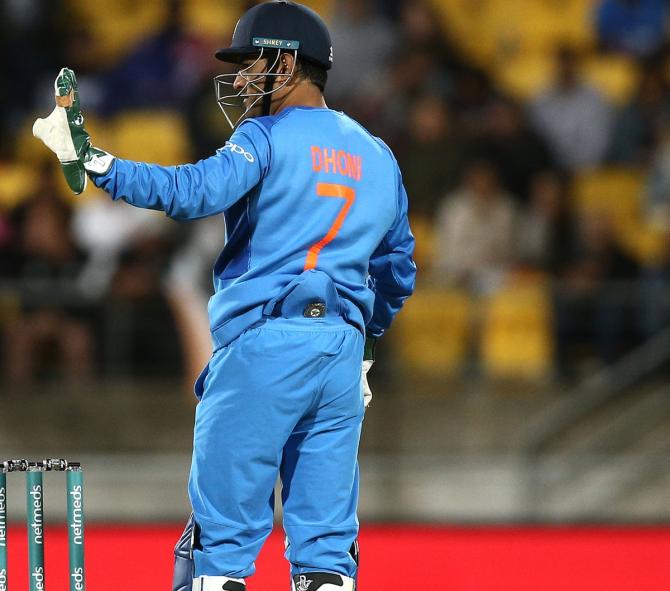
Dhoni's judgment behind the stumps was unmatched in making leg-before calls as well.
His record of successful challenges of the on-field umpire's decisions is probably unmatched.
But more than all this was his precise direction to the bowler as to what length and line to bowl.
We know how well he did it thanks to the stump mike.
And he was tough, taking them to task if they erred.
Not for nothing do younger bowlers such as Chahal and Yadav credit Dhoni for the bulk of their successes.
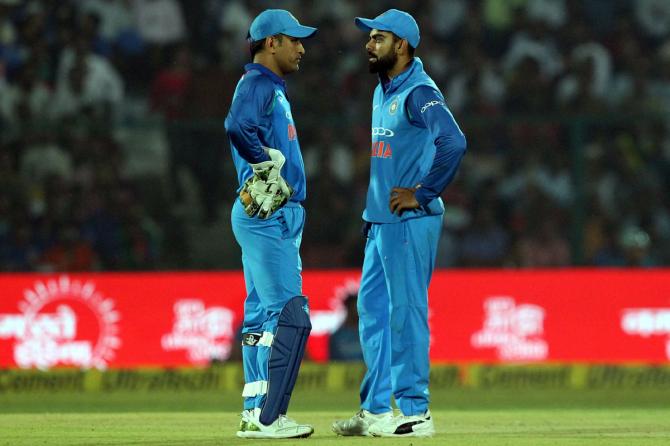
Dhoni continued to perform this role even after he stepped down as captain.
He got along famously with his successor Kohli, who was often seen consulting Dhoni almost as if he was the nurturing prince regent to the new occupant of the throne.
That allowed Kohli the rare luxury to field in the deep, secure in his belief that matters closer to the pitch were in Dhoni's safe hands.
I have often remarked in jest that the opposing team might have a legitimate grouse that India was playing with two captains!
***
Dhoni walked into the Indian team on the strength of his batting.
That remained his claim to fame for almost the entire length of his career.
His run aggregates and averages across the formats are in the same rarefied zone as those of the Fab Four of Indian cricket, Tendulkar, Rahul Dravid, Ganguly and V V S Laxman.
What is remarkable is that he garnered his runs batting mostly further down the order than the illustrious compatriots.
Until the advent of Rohit Sharma and Hardik Pandya, Dhoni was the only reliable Indian who could almost at will steer the ball across the boundary with a flick of his sturdy wrists or soaring into the stands with his famed helicopter shot.
While Dhoni's six centuries in Tests and 10 in ODIs, as well as other high scores, contributed significantly to the team total, his exceptional value to the team was as a finisher.
He was unquestionably the best finisher in the world in limited overs games so far and I say this having watched that other highly valued finisher, Michael Bevan of Australia, a bit before Dhoni's time.
He remained not out in 57 of the 350 ODIs he played, an impressive achievement in itself, and India won 47 of them.
Not much is needed to support the above claim.
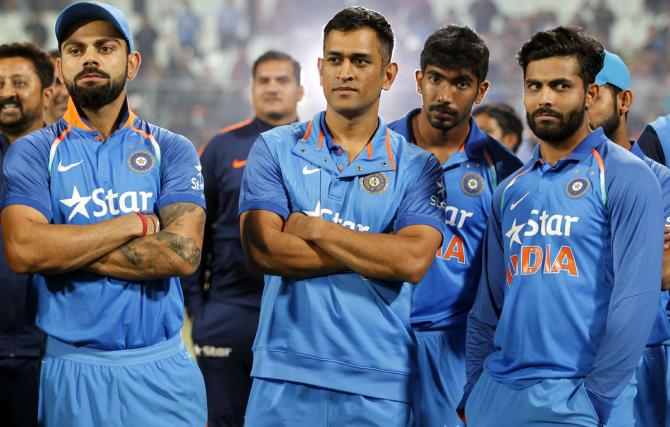
Dhoni perfected the art of finishing.
He would typically come in at number six or seven, with a relatively poor total on the board and mostly the lower order for company.
He took his time to get going, consuming several balls without scoring.
He would then start the slow march with ones and twos, keeping the scoreboard ticking at none too impressive a rate of 4 or 5 an hour.
All this while, he would remember which bowler had how many overs left and whom to target when for runs.
He would advise his partner accordingly.
He would shift gears around over number 44 or 45, unleash his power strokes and finish the game with a flurry of boundary hits, mostly in the last over.
At times this cat-and-mouse chase between the bowlers and Dhoni got too excruciating.
Many is the time I yelled at the television screen while pulling out my hair, "Get on with it Dhoni and deliver us from this misery."
Dhoni had a rather convincing explanation.
He said that if you think the batsmen are under pressure at the death, think of the bowlers, who are under even greater pressure.
They are more prone to commit errors knowing Dhoni is waiting for just that.
And so he bided his time.
Lately, though, this famed touch seemed to desert him rather too frequently for comfort.
His starts were getting slower, he dawdled with his singles too long and the big shots either did not come off or go the distance.
The fickle public began to swing to the view that Dhoni was past it.
It hurt. And how! Cricket chronicler Boria Majumdar said on Dhoni's retirement that in a recent lunch he had with Dhoni, the latter spent most of the two-and-a-half hours discussing that historic run out in the 2019 World Cup semi-final against New Zealand.
Dhoni kept saying that he would have batted from both ends, shielding Ravindra Jadeja (no mug with the bat himself) if required and would not have been fazed if 16 or 17 runs were needed in the last over.
He added things would have been all right if only he had dived (which he had never done earlier) when he saw the Martin Guptil throw coming in straight to the stumps! That was not to be and thus ended the career of the Greatest Finisher of All Times.
***
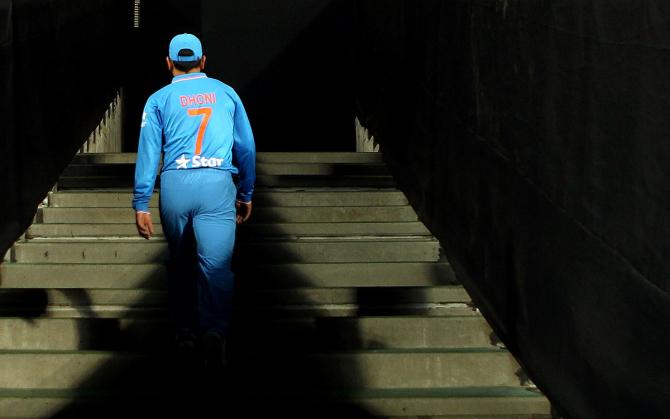
Much is made of Dhoni's small town (Ranchi isn't exactly that, but let it pass) and his rather humble preparations in his formative years.
While true, these circumstances are irrelevant.
Some players are born with innate abilities, even as they constantly hone their skills and work the flaws out of their technique.
They are destined for greatness, regardless of whether they come from Mumbai or Masulipattanam, Ranchi or Rameshwaram.
Sunil Gavaskar and Sachin Tendulkar are the prime examples of this.
And so is Mahendra Singh Dhoni.
Gavaskar repeated the remark he has often made when talking on television after Dhoni announced his retirement.
He said that if he knew he had only a few minutes left on this earth, he would ask someone to play the video of Dhoni's six that won the World Cup in 2011.
Coming as it does from the greatest batsman-thinker of our times, nothing can be a more appropriate tribute to Baahubali Mahendra.
Baahubali captain. This most appropriate coinage by Sandeep Dwivedi, Sports Editor, The Indian Express is gratefully acknowledged.
Shreekant Sambrani is an economist.
Feature Presentation: Aslam Hunani/Rediff.com